The wonderful long-distance footpath that follows the river through the Ouse Valley in Cambridgeshire is one of our greatest assets. The Great Ouse Valley Trust has already replaced the information boards, with the assistance of Highways England and the County Council, but keeping the path clear and safe is not quite so straightforward. Graham Campbell, Chair of the Trust, explains why.
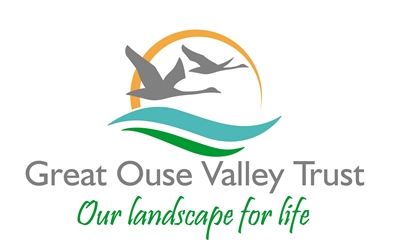
The new A14 has undoubtedly brought many benefits in reducing car journey times. However, it has also had a hugely detrimental impact on one of the most tranquil and beautiful stretches of our Ouse Valley Way footpath.
Much of the section between Brampton and Buckden and Offord Cluny is now dominated by the inevitable noise and visual impact of the new road. A really pressing concern is that the river bank immediately beneath the elevated road is now collapsing into the water. In the darkness of the undercroft the vegetation that once kept the riverbank stable has died and disappeared. National Highways has done its best to tidy up this area but has yet to find any funding for a long-term solution to this potentially dangerous situation. The cost of reinforcing the river bank is small in comparison to the huge cost of the A14 project as a whole. The trustees continue to press for a speedy resolution because, although we are keen to encourage families and individuals to explore our wonderful riverside footpath, we must also ensure it is safe.
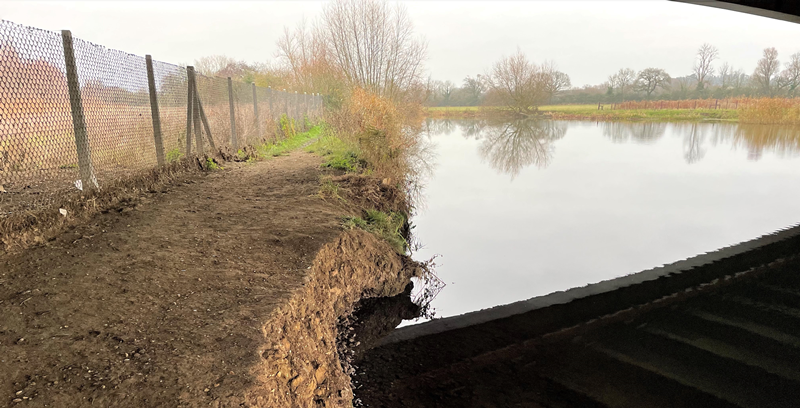
Volunteers can do only so much. To ensure public safety here needs the heavy machinery of the responsible bodies. PHOTOGRAPH BY GOVT
Keeping the footpath accessible throughout the year is in fact one of our major concerns. Although the County Council continues to carry out major repair works, severe funding restrictions over the last 12 years have meant it is no longer able to maintain its footpaths as it would wish, and it has sought support from town and parish councils to carry out the more basic tasks.
During the last two summers the Great Ouse Valley Trust has attempted to coordinate volunteers from our Partner Members to go out and clear nettles and brambles to keep the path open. This has been a great effort with much success but the size of the task was such that some sections of the path nevertheless still became too overgrown for easy access.
The Ouse Valley Way was set out in the 1990s and runs for 151 miles from Syresham in Northamptonshire all the way to The Wash at Kings Lynn. Arguably the section through Cambridgeshire is the finest part. Let’s be proud of our beautiful local countryside and do everything we can to value it.
The Great Ouse Valley Trust promotes for public benefit the conservation, restoration and enjoyment of the landscape, wildlife and heritage of the Great Ouse Valley and environs in the county of Cambridgeshire. For more information about the Trust please visit http://greatousevalleytrust.org.uk and follow us on Facebook.
In the Great Ouse Valley we are fortunate to be surrounded by beautiful countryside. And this means that while we sleep, the wildlife also enjoys our gardens – sometimes to our dismay! Here Bridget Flanagan, from the Great Ouse Valley Trust, describes some of her own experiences.

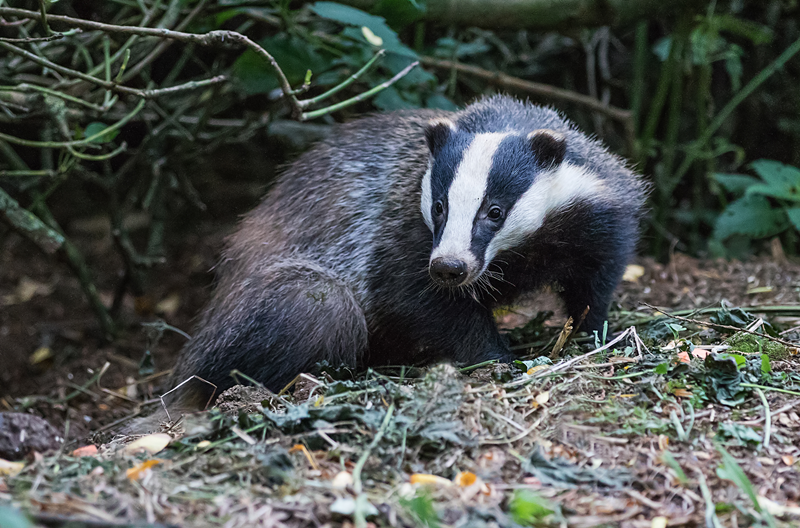
You will either love a garden visit from a Badger, or rue his voracious appetite.
Photograph by Nigel Sprowell
We are very keen on drawing up boundaries and delineating spaces – but nature and wildlife pay them little regard. We generally think of our settlements of town and village as being separate from the countryside. But are we deluding ourselves? If there are attractive opportunities, nature and the inhabitants of the countryside are very keen to come in – and quickly do. Some of them are with us all the time although we may not see them.
We go to great lengths to invite some wildlife to visit our garden spaces – while simultaneously doing our utmost to keep others out. Almost all birds are welcome, and the nation spends fortunes buying food to entice them nearer. Rabbits, on the other hand, are certainly not on our guest list. And then there’s the rest of the visitors, mostly nocturnal, who come uninvited and unannounced – some who leave little trace, and others who disregard house rules, treat the place as their own and leave a mess.
So who are these night visitors? It is a delight to be sitting in the garden, as dusk falls on a warm summer evening, and watch bats darting at insects, or be gradually aware of a hedgehog shuffling in the shadows. The foxes are everywhere. Only a garden ‘militarised’ zone might make them cautious: a quick tour of neighbourhood plots is just their regular evening jaunt.
Food is the big attraction and the wildlife visitors see our gardens as repositories of juicy, tender offerings, often beautifully presented and in great abundance. Easier than having to forage in a hedgerow. The Muntjac deer – seemingly ubiquitous – find the flowers of winter pansies to be irresistible, and even more so when conveniently planted in a pot at head-height. The buds of tulips are a special delicacy, as are the soft shoots of young rose stems and leaves. A recent arrival in my garden is the Badger who takes deep gouges out of the lawn to find grubs and worms. He couldn’t believe his luck when he came across new plantings of crocus and scilla bulbs, so he unearthed and ate the lot. And an even bigger mammal, with a larger appetite, has now appeared. As I returned home one evening last week my car headlights shone on two Roe deer in the front garden. We stared at each other in astonishment, and then they were gone. No doubt they will be back. Whose garden is it anyway?
The Great Ouse Valley Trust promotes for public benefit the conservation, restoration and enjoyment of the landscape, wildlife and heritage of the Great Ouse Valley and environs in the county of Cambridgeshire. For more information about the Trust please visit http://greatousevalleytrust.org.uk and follow us on Facebook.
A family business chalks up 75 years on the river Great Ouse. Ian Jackson, of the Great Ouse Valley Trust, has the story.

When Laurie Jones and his wife Nora converted a wartime landing craft into a houseboat on the banks of the Great Ouse on the meadows at Hartford in 1946, they must have had an inkling that the river offered an opportunity for their future. The 1947 floods surely tested their resolve but, undaunted, they rented a cowshed, previously used as a fire station, and established a business hiring out punts, converting lifeboats and building other assorted river craft. From this humble beginning it is wonderful to now acknowledge that Jones’ Boatyard, a third generation family business, is believed to be the oldest inland marina, brokerage and chandlery in the country!
In 1958 the couple and young family acquired a disused gravel pit alongside St Ives Lock and, after subduing the overgrown thorny wilderness, they built a workshop with living accommodation above, and established moorings. This is still the site of the business today. Back then, and along with a small hire fleet of three boats, Laurie designed and built motor cruisers assisted by son Mick. Later, throughout the 70s, Mick became a boat builder in his own right and his skills can still be admired today in three craft – now classics - that continue to grace the river – Tangle, Fair Wind and Eastmoor, each with a proud owner!
In 2005 Mick’s sons, Ben and Sam, became the third generation to join the yard. They soon set about modernising the moorings and expanding the business by adding a new separate marina just below the lock. This has been done sensitively with landscaped banks planted with characteristic riverside flora that now attracts a wealth of wildlife.
The enduring success of this family firm of course reflects the booming interest in the recreational opportunities offered by the river, and the beauty of the Great Ouse Valley itself, but it is also a testament to an exceptional record for customer service. And as Partner Members of the Trust we are pleased to have the support of LH Jones and Son for the work we do in promoting and protecting the Ouse Valley landscape.

The Jones family celebrates the company achievement. Mick and Carol his wife are centre right, with Ben centre and Sam to his right, surrounded by grandsons and granddaughters – a new generation in waiting perhaps. Photograph by Gilly Jackson
The Great Ouse Valley Trust promotes for public benefit the conservation, restoration and enjoyment of the landscape, wildlife and heritage of the Great Ouse Valley and environs in the county of Cambridgeshire. For more information about the Trust please visit:
TALES FROM THE RIVERBANK
A regular series of stories from the Great Ouse Valley Trust.
BIGGEST REED BED!
We are so lucky. Why? Well, less than a ten-minute drive away (6 miles), to Earith, a wetland reserve is being created that will be larger than any other in the country. It is commonly accepted now that if nature conservation in the UK has any chance of succeeding, it has to be on a big scale. In our area we can feel we are showing the way!
And now, it is much easier for you to see for yourselves. The new entrance is a right turn soon after Hermitage Marina on the Shelford Road to Willingham (B1050). There you will find good parking, signage, picnic tables, trails and viewpoints. And a breath-taking landscape. Waving reed beds and meres stretch into the distance as far as you can see. This is how the Fens must have appeared before they were drained. And this is only the half-way stage of the project – another 15 years to go!
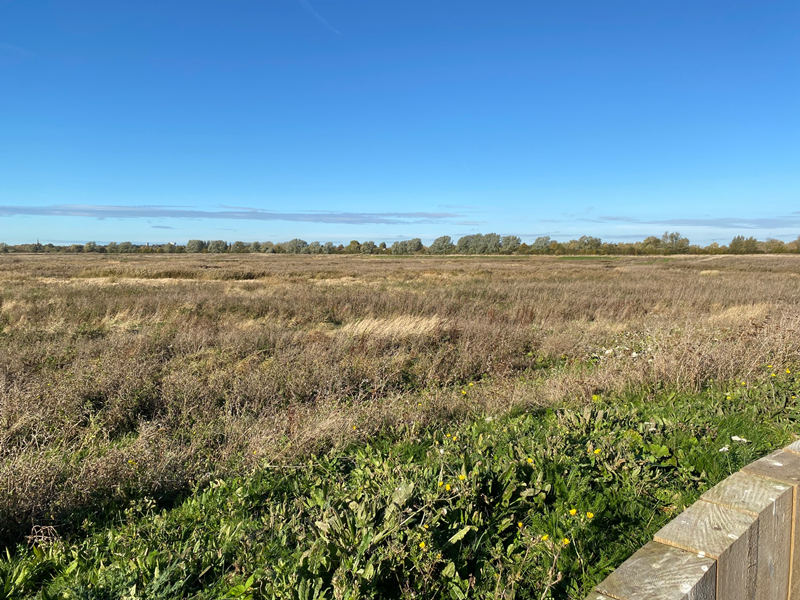
Why is this important? Wildlife habitats are under enormous pressure with many species now endangered from the increasing demands of our growth and development. But wildlife is important too and so we need to balance both needs to ensure a healthy environment for us all. The restoration of wetlands by the RSPB as Hanson extracts the sand and gravel is part of this process. And it is working. Many bird species once common here are now returning in numbers – Bittern, Bearded Tit, Marsh Harrier, Little, Great and Cattle Egrets, for example, plus thousands of wintering waterfowl. Otters too have discovered the area.
Even the humble Starling puts on a show. Vast flocks swoop in to weave fantastic shapes in the sky at dusk before settling into the reeds to roost. This is happening now so pop in (it’s free) about half-an-hour before sunset and marvel at one of the wonders of the natural world – just down the road!
We are fortunate to have opportunities like this in our beautiful Great Ouse Valley. If you are interested in the Trust you can visit www.greatousevalleytrust.org.uk and follow us on Facebook.
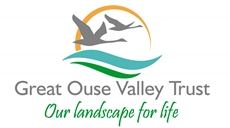
The Great Ouse Valley Trust welcomes local naturalist Jim Stevenson as a contributor to our regular column. Here he describes how our river valley is used as a migration route for a wide range of wildlife but in particular by spectacular birds from Scandinavia - Redwings.

As I write it is late at night and I can hear a rustling, rattling whistling sound overhead, like a bike race in the sky. There are shadows flitting across the moon, though it’s not even Halloween yet. Soon after sun-up the half-lit sky is crowded with squadrons of starling-sized birds that weren’t here yesterday. It’s mid-October and the big autumn migration has really kicked off. This is the time when all the Scandinavian thrushes and blackbirds head our way in search of berries. In their thousands they lift off around sunset and cross the Danish coast at Heligoland where there is a bird-ringing station. They arrive on our east coast on a broad front. The coastal nature reserves in Lincolnshire and Norfolk are good places to greet them as they come in low over the water and drop into the bushes for a rest and a meal. As you read this, they should be widely scattered throughout our area - look for groups of large, well-marked thrushes in fields and bushes.
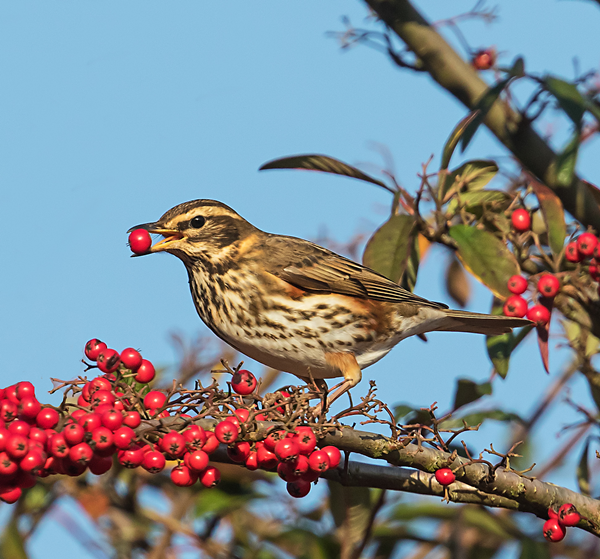
Redwings in their thousands arrive to feast on our autumn berries
PHOTOGRAPH BY NIGEL SPROWELL
Early in October I found two ‘pathfinder’ Redwings at Grafham Water where they were eating blackberries and drinking at a puddle. Then, on the 13th, I woke to see hundreds of them streaming over Brampton. Later in the morning more flocks passed overhead; mostly Redwings but with a few larger Fieldfares among them.
At night these birds use the stars to navigate but by day they follow features like ridges and river valleys. They even follow railway lines, probably because the embankments are often covered with berry-bearing bushes. The Great Ouse provides an obvious route inland from The Wash, not just for land birds but also for wetland birds such as ducks, geese, swans and waders. And it’s not just birds either; there are migratory fish such as Eels, and Common Seals can follow them as far upstream as Bedford. You can find Otter droppings by any weir or bridge along the entire length of the river. I have even seen butterflies migrating along the railway line that follows the Ivel/Ouse valley between Biggleswade and Huntingdon. People use that route too, and have done for centuries.
The valley itself was created by a series of glaciers, the largest of which pushed south all the way to Stevenage. This explains the route of the Great Northern Railway, and the Great North Road, but not the Roman route of Ermine Street that also left London but stuck to the higher ground before crossing the Great Ouse at Godmanchester en route to the Roman hub at Castor (near Peterborough) and beyond to Lincoln and York. The abandoned ‘ghost villages’ along the valley around Little Paxton may attest to the story that the plague travelled this way too.
The Great Ouse Valley Trust promotes for public benefit the conservation, restoration and enjoyment of the landscape, wildlife and heritage of the Great Ouse Valley and environs in the county of Cambridgeshire. For more information about the Trust please visit:


